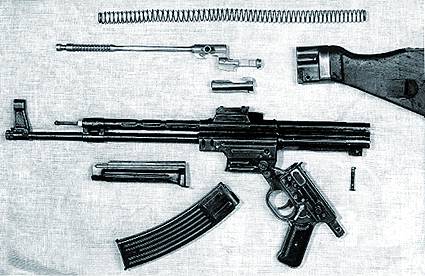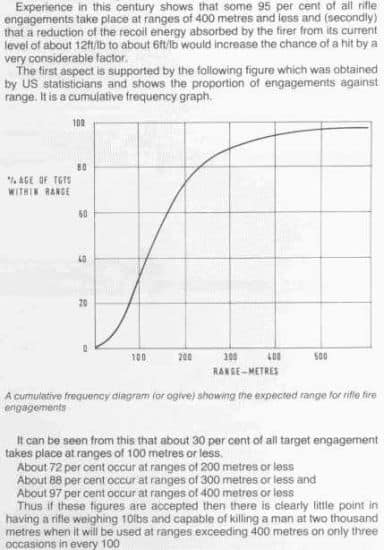Plain Old Dave wrote:Poor accuracy of the M1 in Korea can probably be attributed to poor training in the interwar era. This is a problem the Marines didn't have as they are almost continuously deployed somewhere. Even the Reservists at the Choisin Reservoir were well reported; the Chief of Marine Reserves immediately postwar was the legendary General Lewis "Chesty" Puller and his tenure was noted for emphasis on combat training.
https://www.americanrifleman.org/articl ... p-matters/
The volume at short range vs long range accuracy (or sturmgewehr vs battle rifle if you will) argument has swung back the other way.
I have already posted the OR reports from Korea, they prove otherwise. In the context of WW2, having mass conscript armies and heavy losses precludes the ability to train effectively. Long range accuracy isn't really the issue with the modern M16/SAW round, lethality arguably is. In terms of the StG it's accuracy was enhanced due to it's ability to make quick follow up shots to compensate for aiming mistakes, which was aided by the large magazine relative to the Garand and ability to go full auto controllably within 300m and score hits.
Also the NRA is
probably not unbiased on the subject of heavy rifle long range marksmanship.
Plain Old Dave wrote:
Pulls:
The Army has seldom placed a high priority on small-arms proficiency. In Vietnam, figures sometimes ran 50,000 rounds per enemy killed, but the nature of that war often precluded precise aiming and firing.
The problem is systemic, as noted by Maj. Thomas Ehrhart’s 2009 study, “Taking Back the Infantry’s Half Kilometer.” Ehrhart wrote that the U.S. Army dropped long-range riflery as a primary skill in 1958, deep into the Cold War. Engagement out to 600 meters was replaced by “trainfire,” which emphasized 50 to 300 meters.
That's missing the point of what the M16 in Vietnam was striving for; due to the ability to carry 3 times the ammo suppressive fire to gain fire superiority as well as automatic fire to 'spray and pray' to get hits was emphasized; only McNamara was worried about the round to kill ratio, as he was out of loop of what the military was actually trying to achieve with using so much ammo. There is so much more than round per kill ratios in small arms use.
Trainfire was adopted because combat experience taught that getting hits beyond 300m was nearly impossible anyway even with the weapons capable of it due to aiming errors, while most men only engaged below 300m anyway to ensure hits apparently instinctively. Training was adapted to fit the realities of combat rather than the other way around.
The 'taking back the half kilometer' article is one I've read previously and is mostly in reference to the issues discovered in Afghanistan, which is a serious anomaly in modern combat due to the terrain. The issue is solved by carrying a few DMRs on patrol when it's necessary. Currently the army is also looking into adopting 6.5mm weapons with telescoping ammo to keep weight down and make it a far superior platform to the M14 and 7.62 round.
Plain Old Dave wrote:
This was concurrent with the adoption of the M14. A superb weapon, but it's not hard to conclude the extra 12 shots were added to address dropping precision marksmanship as a military skill.
In 2010, California National Guard S/Sgt. Jeffrey Wall wrote an influential paper for Small Wars Journal. “A Rifleman’s War” immediately caught the attention of marksmen everywhere. A Distinguished pistol shot and former Marine officer, Wall is intimately involved in Army marksmanship training. He notes that 52 percent of Afghan firefights begin at 500 meters or more, placing a premium on skilled riflemen—especially when supporting arms are limited by rules of engagement.
The only problem with using info from the hallowed halls of academia (almost all battles happen within 300 meters), is when the bad guys don't.
The reports I've seen are that the Afghans open fire at long range with old MGs and rifles, but seldom hit anything; they are purposely trying to stay out of range to avoid being murdered at the standard combat ranges and so they can run away when needed; it's harassment fire and hoping they get lucky.
Again the only reason the M16 was even given a chance to be adopted was the huge failure of the M14 in combat in Vietnam. The M16 was the only weapon available in the meantime as Project Salvo was still yet to fail and was being banked on by the military, so it got a chance and proved the far superior weapon.
http://looserounds.com/2015/01/30/the-m ... 14-legend/
https://en.wikipedia.org/wiki/M16_rifle#Adoption
However, despite overwhelming evidence that the AR-15 could bring more firepower to bear than the M14, the Army opposed the adoption of the new rifle.[12][44] U.S. Secretary of Defense Robert McNamara now had two conflicting views: the ARPA report[56] favoring the AR-15 and the Army's position favoring the M14.[44] Even President Kennedy expressed concern, so McNamara ordered Secretary of the Army Cyrus Vance to test the M14, the AR-15 and the AK-47. The Army reported that only the M14 was suitable for service, but Vance wondered about the impartiality of those conducting the tests. He ordered the Army Inspector General to investigate the testing methods used; the Inspector General confirmed that the testers were biased towards the M14.
In January 1963, Secretary McNamara received reports that M14 production was insufficient to meet the needs of the armed forces and ordered a halt to M14 production.[44] At the time, the AR-15 was the only rifle that could fulfill a requirement of a "universal" infantry weapon for issue to all services. McNamara ordered its adoption, despite receiving reports of several deficiencies, most notably the lack of a chrome-plated chamber.[57][1]

